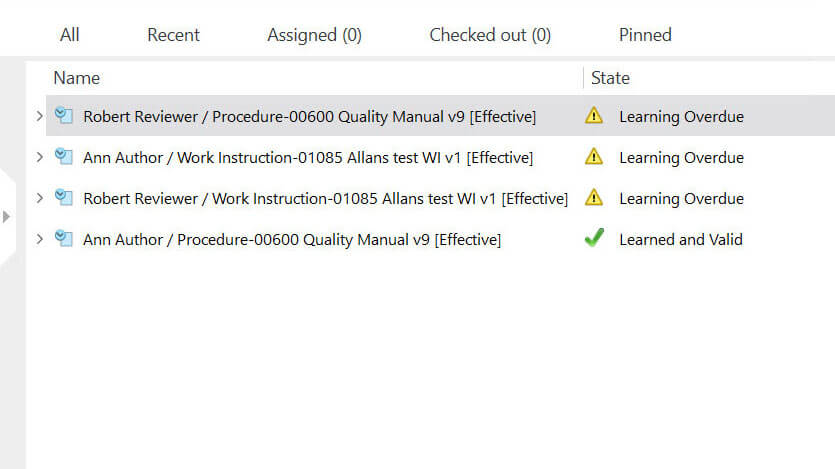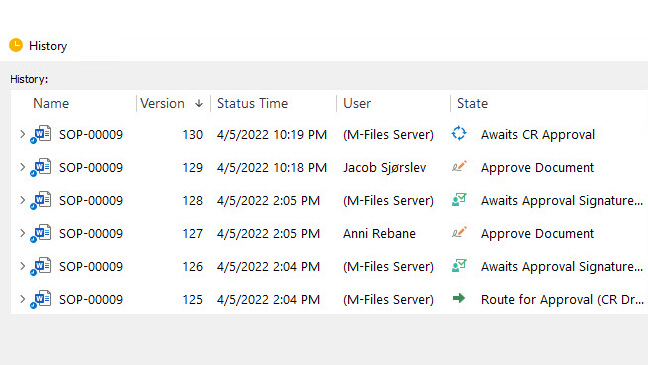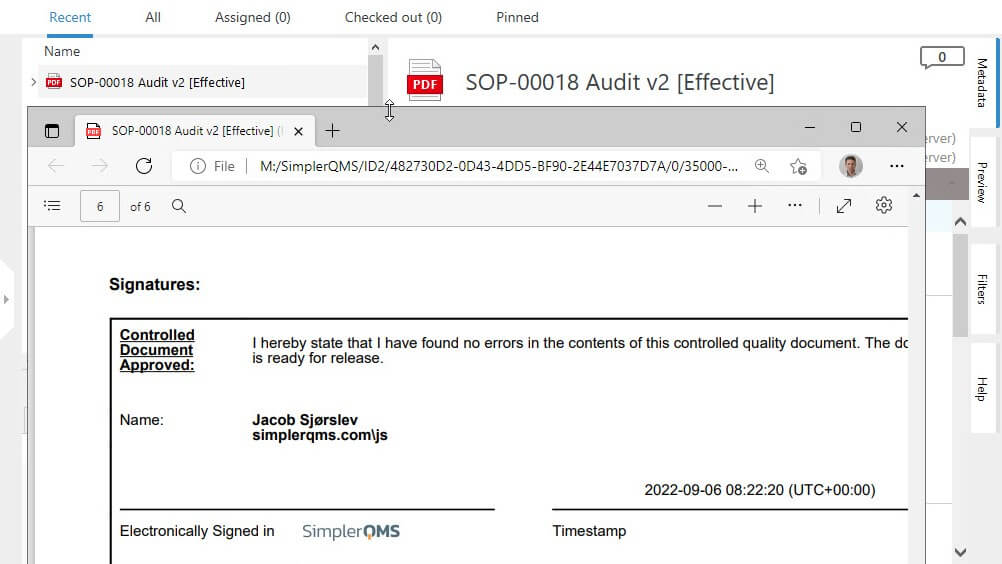The 21 CFR Part 11 is part of US Food and Drug Administration (FDA) regulations specifying electronic record requirements. Among these records are the training records.
It is important to properly manage training records to demonstrate that employees have completed their training and showcase their ongoing training progress.
In this article, we will discuss the significance of training records, mention the records falling under the purview of 21 CFR Part 11, outline the associated requirements, and highlight best practices. Additionally, we will explore how an eQMS can simplify training records management.
Life Science companies are adopting Document Management and Quality Management System (QMS) software solutions that comply with 21 CFR Part 11 to streamline regulated quality management processes, such as training management, and ensure compliance.
SimplerQMS provides QMS software fully compliant with 21 CFR Part 11, designed for Life Science companies. To learn how our eQMS can help you streamline your quality process management and compliance efforts, you can book a demo of SimplerQMS and talk with our system experts.
Learn about 21 CFR Part 11 and training records by exploring these topics:
- Importance of Training Records
- Which Training Records Fall Under the Purview of 21 CFR Part 11?
- Requirements for Training Records Under 21 CFR Part 11
- Best Practices for Managing Training Records
- Simplify Training Records Management and Entire QMS with SimplerQMS
Importance of Training Records
Training records play an important role as they provide documented evidence of the training activities conducted within an organization, ensuring that employees are adequately trained and qualified to perform their assigned tasks.
Inadequate or poorly managed training records increase the risk of noncompliance during regulatory inspections and audits. These can lead to warning letters, product detention, monetary penalties, and company reputation damage.
To avoid these consequences, Life Science companies should have well-maintained training records in compliance with 21 CFR Part 11 requirements, particularly when electronic records are utilized.
The main benefits of well-maintained training records include the following:
- Comprehensive training details: Training records track various aspects of training, including attendance, training effectiveness via quiz results, and more.
- Risk mitigation: Well-maintained training records contribute to effective risk management. Organizations can implement targeted training interventions to address these deficiencies by identifying employee knowledge or skills gaps.
- Audit preparedness: Well-maintained training records facilitate audits and inspections by demonstrating that employees are trained to perform their tasks according to regulatory requirements.
- Competency validation: Training records serve as a documented validation of employee competency. They provide proof that individuals have completed the required training, acquired the essential knowledge and skills, and are qualified to carry out their assigned tasks.

Which Training Records Fall Under the Purview of 21 CFR Part 11?
All training records created, maintained and stored electronically fall under the purview of 21 CFR Part 11.
Some examples of training records that fall under the purview of 21 CFR Part 11 include:
- Training attendance records: These records track which employees have attended training and the date and time of their attendance. The record would typically include the trainer’s name and the training topic.
- Training logs or training registers: These records track the training that employees have received. They can include the date and time of the training, the topic of the training, the trainer’s name, and the employee’s attendance.
- Training assessment results: Assessments, such as quizzes, can help measure an employee’s understanding of the training material. They can be used to identify areas where the employee needs additional training or to track the effectiveness of the training program.
- Training certificates: Certificates demonstrate that employees completed training and have the necessary skills to perform their tasks.
- Training evaluation forms: Evaluation forms are used to collect feedback from employees about the training they have received. The feedback can be used to improve the training program or to identify areas where additional training is needed.
Training records should be retained for the required period. The time that training records must be retained varies depending on the specific industry and regulatory requirements.
Requirements for Training Records Under 21 CFR Part 11
The 21 CFR Part 11 requirements for training records follow the requirements outlined for electronic records. These requirements are designed to ensure training records’ authenticity, integrity, and confidentiality.
This section will explore the requirement for training records under 21 CFR Part 11 and emphasize the most important areas.
NOTE
The information in this article is for educational purposes only. Companies must always refer to the official information in the FDA 21 CFR Part 11 to ensure compliance.
System Validation
The system must be validated to ensure that the electronic system effectively creates, maintains, and stores accurate training records in compliance with 21 CFR 11.10(a). It also should include testing the system’s ability to detect and differentiate unauthorized or modified training records.
Validation is necessary if the electronic system is used to manage processes regulated by ISO 13485, 21 CFR Part 820, EU GMP. These regulations emphasize the importance of using a validated computer system when controlling and documenting regulated processes, such as training management.
Generate Copies of Training Records
The system should generate copies of training records. These copies must be suitable for inspection, review, and copying by the FDA, according to 21 CFR 11.10(b).
This ensures that organizations can provide authorized personnel from the FDA with readily accessible and accurate copies of training records when requested during inspections or audits. Having the ability to generate such copies facilitates compliance with regulatory obligations and streamlines the process of providing evidence of training activities to regulatory authorities.
Retrieval of Training Records
Training records should be stored in a way that allows them to be retrieved accurately and readily throughout the records retention period as per 21 CFR 11.10(c).
This means that Life Science companies should have a process for retrieving training records in response to FDA or employee requests.
Limit Access to Training Records
Access to training records should be limited to authorized individuals to maintain confidentiality and prevent tampering in accordance with 21 CFR 11.10(d).
Companies must implement a secure and dependable process to restrict access, assigning permissions based on license types and user roles.
By implementing access controls, organizations can safeguard the integrity and confidentiality of training records, protecting them from unauthorized modifications or disclosures.
Limiting access ensures that only individuals with a legitimate need to view or modify the records, such as HR personnel, trainers, and management, can access them.
Audit Trails
The system must generate secure and time-stamped audit trails of training records in compliance with 21 CFR 11.10(e).
The audit trails should include precise information, such as the identity of the individual who made the changes, the time stamp indicating when the changes were made, and a clear record of the purpose or reason for each change.
This level of detail ensures transparency and accountability, allowing organizations to track the history of changes made to training records and understand the context behind each modification.

Provide Recordkeeping System Training
Companies should provide training to individuals responsible for using electronic systems to handle training records in accordance with 21 CFR 11.10(i).
This requirement helps ensure personnel have the education, training, and experience to perform their assigned tasks using the system.
Written Policies for Training Records
Companies should establish written policies that hold individuals accountable for training actions initiated under their name, in compliance with 21 CFR 11.10(j).
These policies serve to prevent document falsification and maintain training records’ integrity.
Organizations can set clear expectations and guidelines for proper handling and managing training records by implementing written policies.
Electronic Signatures
Signed training records must contain information associated with the electronic signature in compliance with 21 CFR 11.50. This information includes the signer’s name, date, time, and signature meaning.
Additionally, the electronic signature data, conforming to 21 CFR Part 11 electronic signature requirements, must be included in the training record in both electronic display and printout forms. This ensures that the integrity and authenticity of the electronic signature are preserved, providing a reliable record of the individual’s endorsement of the training record.

Linking Signatures to Training Records
For training records to be protected from being falsified, signatures executed on them must be linked to the corresponding record in compliance with 21 CFR 11.70.
By linking signatures to specific training records, organizations ensure that the signature is intrinsically tied to the content and context of the record. This linkage establishes a clear and unbroken chain of evidence, making it virtually impossible for signatures to be removed or transferred to another document without detection.
In this article, we discussed the training record requirements specified in 21 CFR Part 11. However, in this part of the regulation are several other requirements. Check our dedicated article on 21 CFR Part 11 requirements if you want to learn more.
Best Practices for Managing Training Records
Implementing best practices for effectively managing training records under 21 CFR Part 11 helps Life Science companies achieve and maintain compliance when using electronic records.
Some best practices for managing training records are listed below.
Implement a Validated Electronic System
Validation ensures that the electronic system operates accurately, reliably, and consistently according to its intended performance. By validating the system, companies can have confidence in the integrity of their electronic records.
Moreover, validation is mandatory when using the electronic system to manage ISO 13485, 21 CFR Part 820, EU GMP regulated processes.
Establish Written Policies and Procedures
Companies should establish written policies and procedures to ensure accountability and prevent record falsification when managing training records.
Clear and comprehensive guidelines are essential in this regard.
These policies should clearly outline the responsibilities and expectations of individuals involved in training activities.
Protect Training Records from Unauthorized Changes
System access should be limited to relevant personnel, safeguarding the security and integrity of records. This practice ensures effective record management, prevents unauthorized changes, and protects sensitive information.
Companies should implement user authentication mechanisms like secure login credentials and role-based access controls to restrict access. Regularly reviewing and updating access privileges helps protect records and achieve compliance with data security regulations.
Track Training Records Using Time-Stamped Audit Trails
Time-stamped audit trails allow companies to have a dependable and transparent system for recording training activities.
With time-stamped audit trails, each action associated with training records is recorded along with the date, time, and responsible person. Activities include completing training, answering quizzes, accessing attempts, and so on.
Sign Training Records With Electronic Signatures
Electronic signatures offer a secure and convenient way to sign off training records. They should be unique to one individual and not be reused by, or reassigned to, anyone else.
Electronic signatures should employ at least two distinct identification components – an identification code and a password. This helps ensure the authenticity and integrity of training records by using genuine signatures.
Establish Robust Data Backup and Recovery Process
Effectively maintaining training records involves establishing a robust data backup and recovery process.
Companies should safeguard training records and swiftly recover them in case of unforeseen events or system failures. One way is implementing regular backup schedules, utilizing redundant storage, securing backup data, performing verification tests, and documenting the recovery process.
Simplify Training Records Management and Entire QMS with SimplerQMS
SimplerQMS is a comprehensive QMS software that helps Life Science companies achieve and maintain 21 CFR Part 11 compliance.
Our software is designed to streamline quality management processes, including training management.
The Training Management Software module from SimplerQMS provides companies with easy control management over their employee training records.
The Training Management module allows training managers to define specific documents for learning and assign them to individuals or job roles. They can also set a timeframe for learning the training material, create quizzes to assess the effectiveness of the training, and use electronic signatures to streamline the process.
The module also enables training managers to create training plans that outline employee training schedules. The system sends reminders and notifications about upcoming training activities and due dates.
In addition to the robust Training Management module, we offer all Life Science QMS modules, which include document management, change control, audit management, CAPA, customer complaints, supplier management, and more.
SimplerQMS supports compliance with several Life Science requirements, such as FDA 21 CFR Part 11, EU GMP Annex 11, ICH Q10, MDR and IVDR, FDA 21 CFR Part 210, 211, and 820, ISO 13485:2016, ISO 15189:2022, and more.
Our eQMS Business Case template can help you identify the value of an eQMS solution and communicate it to stakeholders. It serves as a guide for assessing your organization’s needs, identifying the benefits of an eQMS, and developing a business case for implementation while ensuring that all relevant factors are considered.
Final Thoughts
The FDA outlines electronic records and signature requirements in the 21 CFR Part 11. The regulation sets forth requirements for creating, maintaining, and using electronic records, that includes training records.
Training records provide evidence of employee training. They demonstrate an employee’s progress in training, indicating, for instance, training completion.
Companies across various Life Science industries are adopting 21 CFR Part 11-compliant electronic systems to securely manage documentation, including training records.
SimplerQMS offers eQMS software to help Life Science companies streamline quality management processes, including training management, and achieve compliance.
If you are interested in learning more about 21 CFR Part 11 compliant QMS software and how SimplerQMS can help you meet your compliance needs, book a demo today.